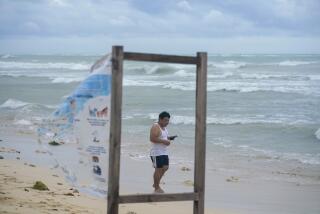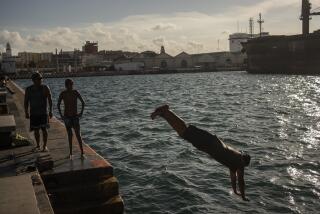Much of Countryside Spared but 300 Die
- Share via
For once, it seems, the poor countryside of Mexico did not bear the brunt of suffering.
In the four-state corridor of southwestern Mexico where the earthquake rippled through on Thursday morning, the rocky hardpan apparently held. Mexican newspapers estimated Friday that across the four mountainous provinces--Jalisco, Michoacan, Guerrero and Colima--the quake killed about 300 people, one-tenth of the suspected fatalities in Mexico City, a city built on what was once a lake bottom.
Along Mexico’s Gold Coast, the chain of costly resorts stretching from Acapulco nearly 300 miles north to Playa Azul, the resort town of Ixtapa-Zihuatanejo reported that five hotels were damaged. One resident in a private home died.
Jennifer Burgess of the Holiday Inn chain headquartered in Memphis, Tenn., said: “We have not heard from (the Holiday Inn) Ixtapa yet, we are still frantically trying to get in touch.”
‘Minor Crack’
The Hyatt hotel chain, with two hotels in nearby Acapulco, reported “a minor crack in the structure at Hyatt Continental Acapulco,” which was still open for business, spokeswoman Christa Brantsch said.
Farther up the coast, 30 people were reported killed when two hotels collapsed at the Playa Azul beach resort in the state of Michoacan.
But at the Sisters of Social Service convent in Zacapu, a small central Michoacan city, Sister Virginia Fabilli said the 20-year-old two-story reinforced concrete building “swayed back and forth. It seemed to me that it moved at least a foot. You could see the walls moving.”
Residents checking their mostly one-story homes and businesses for damage Friday found only minor cracks. The town’s 16th-Century cathedral is said to be intact.
On Friday morning, Fabilli took a bus to La Escondida, a farm village 15 miles away, where she comforted a still-shaken woman who told her that she had run out of her house when the earthquake started.
‘Field Swayed’
“The lady told me that she stood there and watched the cornfield,” where the stalks had grown to 8 to 10 feet tall. “The lady said the field swayed back and forth, the corn going down to the ground on one side coming up and going down to the ground on the other. The houses did not fall down--they aren’t high enough.”
Some are of adobe, and some of rocks dug out of the earth. “It seems,” Fabilli said, “in these little villages they are really safer off.”
In Ciudad Guzman, a city of about 100,000 in the state of Jalisco, newspapers were reporting that the San Jose Cathedral was seriously damaged, and that about 25 people were killed there and in their homes.
But in Gomez Farias, a village outside Guzman, the parish church of San Sebastian saved lives. When the earthquake hit during morning Mass, the church bell tower fell, but the priest ushered parishioners under the strong supporting arches, and no one was killed or hurt.
Cars Only Casualties
In Guadalajara, with its huge American colony ringing the shores of nearby Lake Chapala, the only casualties were 10 brand-new Chryslers, ruined when the roof of an automobile agency fell in, reported Fire Department Lt. Jorge Estrada, who said he believed no more than 30 people died in the entire state of Jalisco--and most of them in the southern part of the state. On Thursday, Fire Lt. Juan Sanchez had estimated 110 to 150 dead in the state.
Since the earthquake hit Thursday morning, the spotty communications, with phone and telex lines down, had created an ominous silence that to many bespoke a wider disaster than actually seemed to have occurred in the provinces.
More to Read
Sign up for Essential California
The most important California stories and recommendations in your inbox every morning.
You may occasionally receive promotional content from the Los Angeles Times.














